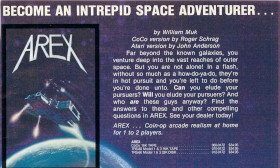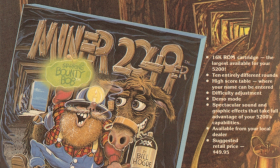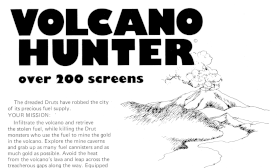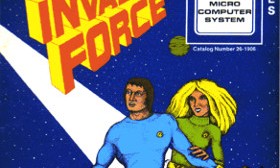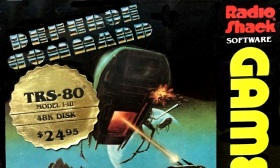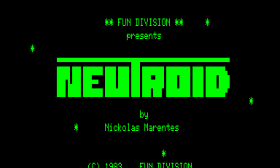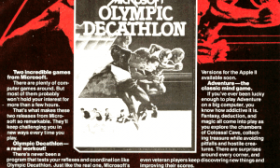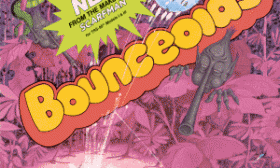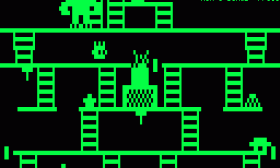Articles in the "Arcade Games" Category
Arex, written by William Muk Koon Yet, was one of the last games Adventure International sold for the TRS-80 Model I and III. It cost $34.95 for both the disk and tape versions when it was released in late 1982. As with many of their other games, Adventure International adapted Arex for multiple computers:
- The Apple II version (for disk only) was written by Gordon Eastman.
- The Atari 400/800 version (for disk and tape) was written by John Anderson.
- The Commodore 64 version (for disk and tape) was a conversion by Philip Case of John Anderson’s Atari version.
- The IBM PC version (for disk only) was written by Philip Case.
- The TRS-80 Color Computer version (for tape only) was written by Roger Schrag.
(Read more...)
Bill Hogue, through his company Big Five Software, was known for producing some of the best games available for the TRS-80 Model I and III. Games like Galaxy Invasion and Robot Attack were legendary in TRS-80 circles. But Bill Hogue and Big Five Software’s most successful game wasn’t for the TRS-80. It was Miner 2049er, the 1984 Electronic Game of the Year. Miner 2049er was an Atari platform game with ten levels that had versions available for more computers than any other game at the time.
Here is a description of Miner 2049er from a 1983 Big Five Software flyer:
(Read more...)
Volcano Hunter was one of the final games to be commercially released for the TRS-80 Model I and III. It was written by David Smith and sold through his company, Lap Video Entertainment. It cost $19.95 for the cassette version and $22.95 for the disk version. A review in 80 Micro described Volcano Hunter as an “ingenious machine-language, arcade-style adventure game.”
Here is David Smith’s description of the game:
You are HUNTING HARRY, the last person left in a town taken over by Druts. (A Drut is a monster that usually lives inside the earth near volcanoes.) The town you live in just happens to be near a volcano. The dreaded Druts have been mining the volcano for its gold, but they have run into a problem. They ran out of fuel for their machines to mine the volcano. So they robbed the city of its precious fuel supply and they plan to keep it. It is your duty to infiltrate the volcano and retrieve the stolen fuel, while killing the Drut monsters who will try and stop you. It may take you a while to find all the fuels because there are over 200 screens in this adventure.
(Read more...)
Invasion Force (catalog number 26-1906) was one of the first action games Radio Shack published for the TRS-80 Model I. It was written by Robert Arnstein and introduced in 1979 on cassette for a price of $14.95. There never was a disk version of Invasion Force.
Invasion Force was very similar to Trek-80, a game for the Sol-20 computer that was probably also written by Robert Arnstein. Here is a description of Invasion Force from an article titled “A New Real-Time Space Adventure That Puts You in Command of Your Own Starship” from the June 1979 issue of the TRS-80 Microcomputer News:
Take command of the USS Hephaestus and protect the galaxy against the hated and feared Jovians. The Command Control Display (TRS-80 screen) places all the ship’s resources at your fingertips.
(Read more...)
Most people considered the Big Five Software games to be the finest games ever written for the TRS-80 Model I and III. They were sold directly through Big Five Software and were resold by many other companies.
Radio Shack also sold Big Five Software games in two collections compiled by Cogito Software. Games Pack Two and Games Pack Three first appeared in the 1984 Radio Shack catalog and contained four Big Five games: Defense Command, Stellar Escort, Cosmic Fighter and Meteor Mission 2. As the packaging stated: “You can look forward to hours of fun for the family, friends, or even the gang at the office.”
Both collections were sold on cassette and self-booting disk. Only minor modifications were made to the games, the biggest being that all copyright messages were changed to “Licensed to Tandy Corporation.
(Read more...)
Neutroid was written by Nickolas Marentes in 1983 and sold through his company, Fun Division (known earlier as Supersoft Software). It was the third of seven games that he wrote for the TRS–80 Model I and Model III. Nickolas Marentes became better known for his later TRS–80 Color Computer games such as Donut Dilemma (which began with a Model I version) and Rupert Rythym.
Marentes was inspired to write Neutroid after reading an interview with Tim Skelly, the author of the 1982 Gottlieb arcade game Reactor. Although Neutroid doesn’t resemble Reactor in any way, they both share a similar abstract concept of manipulating particles within an enclosed space to prevent a nuclear disaster.
(Read more...)
Olympic Decathlon, sometimes known as Microsoft Olympic Decathlon, was one of the first sports related programs to mix game and simulation. It was written by Timothy W. Smith and sold by Microsoft Consumer Products. The original TRS-80 version cost $24.95 and was released in 1980. It was followed by an Apple II version in 1981 and an IBM PC version in 1982. Although the program used both the word “Olympic” in its title and the Olympic rings symbol, the program manual makes no mention of a license from the International Olympic Committee. The lack of a license might be why the 1982 IBM PC version was renamed Microsoft Decathlon and all references to the Olympics were removed.
Contrary to what is sometimes claimed, Olympic Decathlon was not based on the similar Konami arcade game Track and Field, but actually predated it by several years. Olympic Decathlon was created by Timothy Smith, a former systems programmer for Burroughs Corporation. Smith wanted to write a sports game, but didn’t want to pick an obvious sport such as baseball or basketball. Instead, he chose to base a game on the decathlon, a grueling two-day competition that is comprised of ten track-and-field events:
(Read more...)
There were many unofficial adaptations of the Atari arcade game Asteroids written for the TRS-80. Super Nova from Big Five Software and Planetoids from Adventure International were considered among the best.
Bounceoids (not “Bounceroids” as some sources state) was an Asteroids-inspired game written by Robert Pappas (author of Frogger and Crazy Painter) and sold by the Cornsoft Group. It took the concept behind Asteroids and gave it an intriguing twist: what if asteroids didn’t wrap around the sides of the screen, but bounced off the sides instead?
Although this might sound like a minor difference, having the asteroids bounce completely changes the gameplay. The same playing strategies that work in Asteroids (some of which also work in Super Nova and Planetoids) don’t work in Bounceoids. In particular, the movement of the bouncing asteroids means that the player must move almost constantly to avoid them.
(Read more...)
Armored Patrol was one of the most popular TRS-80 games, described by Owen Linzmayer in Creative Computing as “a classic in every sense of the word.” It was distributed by Adventure International and written by Wayne Westmoreland and Terry Gilman, the first of their games for the TRS-80. Unlike their other Adventure International games, Armored Patrol was never ported to any other computers.
Armored Patrol was based on the arcade game Battlezone, released by Atari in 1980. Battlezone used vector graphics to depict a tank battle with a first-person 3‑D view, a real innovation at the time. The player controlled a tank that could rotate 360 degrees. The goal was to destroy the enemy tanks that could be anywhere on the battlefield, even behind the player. Other obstacles were pyramids, which could block the enemy tanks, and even the occasional UFO.
Here is an overview of Armored Patrol from a 1982 Adventure International catalog:
(Read more...)
Wayne Westmoreland and Terry Gilman wrote some of the best games for the TRS-80 Model I and III, including classics such as Sea Dragon and The Eliminator. When Wayne Westmoreland released all of their games to the public domain in 1995, TRS-80 owners received an unexpected treat: Donkey Kong, a previously unreleased TRS-80 game.
Donkey Kong was based on the Nintendo arcade game of the same name from 1981. The hero of the Nintendo game is a carpenter named Mario (who later became better known in the game Mario Bros). The goal is to rescue Mario’s girlfriend Pauline from the marauding Donkey Kong. Mario needs to reach Pauline at the top of the screen, all the while dodging barrels thrown by Donkey Kong. Other obstacles include conveyor belts, elevators, and fireballs.
(Read more...)
Space Colony was a TRS-80 adaptation of the 1978 Taito arcade game hit Space Invaders. It was written by Kim Watt and sold through his own company, Breeze Computing. Kim Watt was better known in the TRS-80 world for his disk utility, Super Utility. Some sources say that Space Colony was also distributed by Adventure International, but I haven’t found it listed in any catalog.
Interestingly, Space Colony wasn’t the first version of Space Invaders that Kim Watt wrote for the TRS-80. He had earlier written Invaders, a game distributed by Level IV Products. Space Colony was a good rendition of Space Invaders and had superior graphics and game play to Invaders. But it had one very unusual feature: it was one of the few commercial high-resolution Model I games.
(Read more...)
Crazy Painter qualifies as one of the few completely unique TRS-80 games. It was written by Robert Pappas, author of the TRS-80 games Frogger and Bounceoids. Crazy Painter was released by the Cornsoft Group in 1982. In addition to the TRS-80 version, the Cornsoft Group also released a version of Crazy Painter in 1983, written by Charles Guy, for the TRS-80 Color Computer. But there was no connection to the 1983 BBC Micro game named Crazy Painter, which was sold by Superior Software.
The goal in Crazy Painter is to completely fill the screen using a paint roller. This is a lot harder than it sounds because various obstacles, including roaming dogs and snakes, show up to ruin what you have already painted and hinder your efforts. Unlike most other arcade style games at the time, Crazy Painter is completely non-violent (unless you consider painting to be violent).
(Read more...)
Panik was not based on any particular arcade game; as one advertisement described it: “It has a little of all arcade games built in, but is its own original game.” It was written by William Demas, author of three other games for the TRS-80:
- Scott Adams’ Adventure #12 (sold by Adventure International)
- Forbidden Planet (sold by Fantastic Software)
- Forbidden City (sold by Fantastic Software)
One of the advertisements for Panik contained this overview:
(Read more...)
Cosmic Patrol was a TRS-80 game written by Mike Wall, better known as the co-author of the excellent Lunar Lander game for the TRS-80. It was published by Wayne Green’s software company, Instant Software, costing $14.95 for a tape version and $19.95 for a disk version.
Cosmic Patrol appears to have been based on Cosmic Conflict!, a 1978 game written for the Magnavox Odyssey 2 home video game system. The goal is simple: destroy 15 vessels in the Quelon fleet before running out of E-units. Each game begins with 999 E-units. Each shot fired, whether it hits anything or not, costs ten E units.
(Read more...)
Time Runner is a TRS-80 game written by Yves Lempereur, the seventh of nine games that he wrote for the TRS-80. It was inspired by Amidar, an arcade game created by Konami in 1981.
Funsoft released three versions of Time Runner for different platforms:
- a TRS-80 version, written by Yves Lempereur, was released in 1982
- an Atari 400/800 version, also written by Yves Lempereur, was released in 1982
- a Commodore 64 version, written by Scott Maxwell and Troy Lyndon, was released in 1983
(Read more...)
The Eliminator, distributed by Adventure International, was an adaptation of the arcade game Defender, released by Williams Electronics in 1980. Adventure International sold The Eliminator (the definite article “the” was part of the title) for several computers:
- the TRS-80 version, written by Wayne Westmoreland and Terry Gilman, was released in 1981
- the Apple II version, written by John Anderson, was also released in 1981
- the Atari 400/800 version, written by Steve Coleman, was released in 1982
Here is the description of the TRS-80 version of The Eliminator from a 1981 Adventure International catalog:
(Read more...)
Sea Dragon, written by Wayne Westmoreland and Terry Gilman, was one of the most popular games for the TRS-80. It was released in 1982 by Adventure International, which also sold versions for other computers:
- the Apple II version, written by John Anderson, was released in 1982.
- the Atari 400/800 version, written by Russ Wetmore (Star Systems Software), was released in 1982.
- the TRS-80 Color Computer version, written by Jim Hurd (Coniah Software), was released in 1983.
- the IBM PC version, written by Dan Rollins, was released in 1983.
- the Commodore 64 version, written by David H. Simmons, was released in 1984.
Along with Time Bandit and Arex, Sea Dragon was the TRS-80 game that was adapted to the greatest number of computers.
(Read more...)
Time Bandit, written by Bill Dunlevy and Harry Lafnear, was a TRS-80 Model I/III game first released by Computer Shack in 1983. Computer Shack (which changed its name to Michtron in 1984) also released versions of Time Bandit for a number of other computers:
- the TRS-80 Color Computer (also released in 1983)
- the Sanyo MBC-550 (released in 1984)
- the Atari ST (released in 1986)
- the Amiga (released in 1988)
- the IBM PC (released in 1988)
The Atari ST and Amiga versions in particular remain quite highly regarded today.
(Read more...)
The original version of Rear Guard was written by Neil Larimer for the Apple II. It was released by Adventure International, Scott Adams’ company, which also commissioned versions for other computers:
- John Anderson wrote the Atari 400/800 version
- Jim Hurd wrote the TRS-80 Color Computer version
- Wayne Westmoreland and Terry Gilman wrote the TRS-80 Model I/III version
One Adventure International advertisement described Rear Guard this way:
(Read more...)
Starfighter, written by Sparky Starks, falls somewhere between an arcade game and a simulation. Far more than a shoot-em-up game, the incredibly detailed scenario in Starfighter lends itself to a game that can be played for hours. Although a unique game, Starfighter has some similarities to Star Raiders, a 1979 game for the Atari 800 that was written by Doug Neubauer.
Sparky Starks later wrote a version of Starfighter for the Atari 400/800 using the name Destiny: The Cruiser. A new name was required because Adventure International had already sold the rights to the name Starfighter to be used by the movie The Last Starfighter.
The goal in Starfighter is to pilot a spacecraft, the SC-78503 Starfighter, and destroy hostile enemy spacecraft. From a description in an Adventure International catalog:
(Read more...)
Wayne Westmoreland and Terry Gilman wrote some excellent games for the TRS-80 from 1981 to 1983, including Sea Dragon and Armored Patrol. In 1995, Wayne Westmoreland released all of those games into the public domain.
Here is a description, written by Wayne Westmoreland in 1995, for each of the games.
(Read more...)
Rally was written by J. Weaver Jr. (Factory Programming) and distributed by Soft Sector Marketing. Rally was based on Rally-X, which was released by Namco in 1980.
The goal in Rally is to collect all of the flags in a maze, while avoiding “enemy cars”. Touching an enemy car causes you to lose your life.
(Read more...)
Devil’s Tower was written by John Olsen and released by Fantastic Software in 1982.
The player starts the game on the left, separated from the Attackers by a tall mountain in the center of the screen. The goal is to shoot over the mountain and destroy the Attackers on the other side. To complicate matters, the Attackers shoot back at you, often displaying an uncanny ability to predict where you are moving.
(Read more...)
Scarfman was based on the arcade game Pac-Man, which was released by Namco in 1980. It was written by Philip Oliver and distributed by the Cornsoft Group. The Cornsoft Group also released a version of Scarfman for the Color Computer.
The game starts with you (the “Scarfman”) at the bottom of the screen. Like Pac-Man, the goal of Scarfman is to eat all of the dots on the screen. You earn points for every dot eaten.
(Read more...)
Although there were many Frogger adaptations for the TRS-80, this Cornsoft Group version was licensed by Sega and was the “official” Frogger. The premise of Frogger is simple. The goal is to guide as many frogs as possible back to their homes, crossing a busy road and dangerous river in the process.
The TRS-80 version of Frogger offers the choice of five difficulty levels and an option to play background music. The famous theme music, taken from the Japanese children’s song “Inu No Omawarisan”, is the same as used in the original arcade version. Most TRS-80 games played music during title screens and sound effects during the game. Frogger was one of the few to also play background music during the game, not an easy feat on a computer with no sound controller.
(Read more...)
Outhouse is probably the TRS-80 game with the most bizarre premise. It was written by J. Weaver Jr. (Factory Programming) and distributed by Soft Sector Marketing.
Outhouse was later rewritten for the Color Computer by the same author, but sold through Computer Shack.
(Read more...)
Nukliex was written in 1984 by Dennis Lo, and released through JMG Software International. Although the game’s title screen identifies itself as “Nukliex”, it was always advertised as “Nucliex”.
When you start Nukliex, you can select a difficulty level between 1 and 10. You control a ship located at the bottom of the screen that fires shots toward the top. Asteroids and aliens attack you from above. This is pretty standard for most games of this type. But unlike other games, you can also move your ship not just side to side but also up and down. Your ship also has a shield that will protect it when you press the ENTER key. The shield takes time to regenerate itself, so you need to use it sparingly.
(Read more...)
Apple Panic was based on the arcade game
Space Panic, released by Universal in 1980. The original version was written for the Apple II by Ben Serki in 1981 and sold by Brøderbund Software. There were also versions of
Apple Panic sold for the Atari 400/800 and the IBM PC (both written by Olaf Lubeck) and for the Commodore VIC-20 (by Creative Software). The TRS-80 version was written by Yves Lempereur in 1982 and published by Funsoft, the fifth of nine games that he wrote for the TRS-80.
(Read more...)
Galaxy Invasion Plus was an update to
Galaxy Invasion with a few new features added. An important difference from the older game is the voices. The speech include “Galaxy Invasion” (at the title screen), “Prepare to die, human!” (as the game starts), and “Game over, Player 1” (when the game ends). Other phrases that are used include: “You’re dead!”, “Flagship alert!”, and “Extra ship!” If you achieve a high score, the game says, “Great Score, Player 1”. But if you beat the top score, it says “Super Score, Player 1”. The speech is very clear and one of the best examples of voice in a TRS-80 game.
(Read more...)
Weerd was written by Arthur Gleckler and released in 1982. It was the final TRS-80 game released by Big Five Software, and only one of two not written by Bill Hogue.
Weerd was released near the very end of the TRS-80 game market.
(Read more...)
Defense Command was the last TRS-80 game written by Bill Hogue. It was very loosely based by the arcade game Defender, which Williams Electronics released in 1980.
Defense Command has the best and clearest voices of any Big Five Software game. It also has very clever graphics and transitions between different screens. In my opinion, Defense Command is the most impressive of the Big Five Software games for the TRS-80.
(Read more...)
Stellar Escort was written by Jeff Zinn, and it was the first game distributed by Big Five Software that wasn’t written by Bill Hogue.
Stellar Escort has a very distinctive look because of the flashy transition effects when changing screens. There is always something in movement on the screen.
Stellar Escort has a number of sound effects, but no music or voices.
(Read more...)
Cosmic Fighter was loosely based on
Astro Fighter, which was released by Data East in 1980. In many ways, Cosmic Fighter looks similar to
Galaxy Invasion. However, the similarities are superficial and the games are very different. Your goal in
Cosmic Fighter is to shoot the aliens as they descend from the top of the screen. Unlike
Galaxy Invasion, you have a limited fuel supply which is used up as you move and shoot. A gauge at the top of the screen indicates how much fuel you have left. Your ship can be destroyed either by hitting an alien or shot or by simply running out of fuel. You are not likely to run out of fuel in the earlier levels of the game, but it does becomes an increasing problem in the later levels.
(Read more...)
Many people remember the distinctive prelude to
Attack Force, which was obviously inspired by the opening to the
The Outer Limits television show. The final part of the prelude takes the video screen out of focus and makes a buzzing sound (without any audio amplifier attached). This effect is created by rapidly switching between normal and double-wide video mode, destabilizing the video synchronization on a Model I or III. The Model 4 features a more robust video system and the video just becomes fuzzy. The buzzing sound is created by rapidly toggling the cassette relay.
(Read more...)
Many people thought that
Galaxy Invasion was based on
Space Invaders (including a reviewer for
80 Microcomputing), but this was a common misconception. Galaxy Invasion was based on the arcade game
Galaxian, which was released by Namco in 1979.
(Read more...)
Meteor Mission 2, also known as
Meteor Mission II, was based on Taito’s 1979
Lunar Rescue, although it differs from it in many ways. Despite the name, Meteor Mission 2 is not a sequel to Bill Hogue’s earlier
Meteor Mission. Amusingly, the first Alpha Products advertisement to feature
Meteor Mission 2 mistakenly used pictures from
Meteor Mission instead.
(Read more...)
Meteor Mission was Bill Hogue’s first TRS-80 game. It is usually not included in listings of Big Five Software games, and some sources have denied that it was ever sold. But it was advertised in the August, September, and October 1980 issues of
80 Microcomputing. It seems to have been withdrawn at that point, and it never appeared in any future advertisements. I don’t know how many copies of
Meteor Mission were ever sold (I’ve only ever seen one copy). Unlike the other Big Five games, there was only a Model I cassette version, but it would work on a 4K Level I computer.
(Read more...)
Super Nova was based on the very popular arcade game Asteroids, which was released by Atari in 1979. It was the first big success for Bill Hogue and Big Five Software.
Originally, Super Nova was available only on cassette tape. It required a Model I with 16K and Level I or Level II BASIC. Later, Big Five Software sold a disk version which saved high scores and required a 32K Model 1. They also sold both cassette and disk versions for the Model III.
(Read more...)
Robot Attack was based on the arcade game
Berzerk, which was released by Stern Electronics in 1980. The game concept itself is older than that, and can be found in any number of BASIC games, such as
Chase,
Robots, and
Daleks.
Robot Attack was notable as the first talking game released by Big Five Software. The game supports the TRISSTICK and Alpha Joystick, but not the original STICK-80 (unless you perform a hardware modification to it). In my opinion, it makes the best use of the joystick of any TRS-80 game.
(Read more...)
